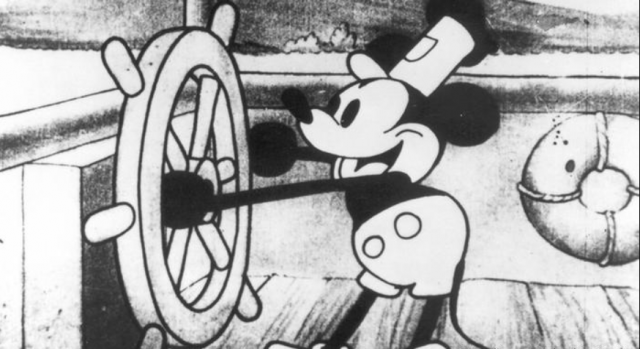Disney will soon lose copyright to original Mickey Mouse
Copyright for the earliest version of Mickey will expire in 2024 but what does this mean for the renowned mouse?

In 2024, the earliest iteration of Disney's Mickey Mouse will enter the public domain. Mickey Mouse first appeared in 1928 in the animated short film Steamboat Willie — the first animation film to use synchronized sound.
In the US, copyright for original works of authorship last until the author's death plus 70 years. But for works created anonymously, pseudo-anonymously or by an employee as part of their job, it lasts 95 years. Works published before 1978, like Mickey Mouse, only have a copyright of 95 years from the date of publication.
While the first version of Mickey Mouse is nearing the end of its 95-year copyright protection, the mouse has had a few transformations since 1928, and subsequent versions of Mickey Mouse will still be protected until their 95 years runs out. The original Mickey Mouse looks quite different to the warm and round mouse seen today. He had a pointy rat-like nose and skinny arms and legs.
While Disney may lose the copyright to Steamboat Willie, they may still maintain some rights if that version of the mouse is recognized as a trademark. "The first question is whether Disney is using Steamboat Willie not just as a character but also as a symbol of Disney," Jane Ginsburg, a professor of literary and artistic property law at Columbia Law School in New York, told DW.
Copyright vs. trademark
A trademark is a recognizable symbol or expression that is connected to a product or service from a particular company or individual, and unlike copyright, they can last forever. In the US, a trademark doesn't have to be registered to be considered a trademark.
If the version of Mickey Mouse seen in Steamboat Willie is seen as a symbol of Disney, the company can say it is a trademark. This means people can use the characters but it must be done in a way that people do not mistake the work as being from Disney.
Winnie-the-pooh as a serial killer
For example, the original stories and characters of A A Milne's Winnie-the-Pooh (1926) joined the public domain at the beginning of 2022. But Disney's iconic image of the character, the yellow bear with a red T-shirt that first appeared in a short animated feature in 1966, is still under copyright. The entertainment giant also maintains a hold on several trademarks related to the popular teddy, which restricts the use of the character's image on products.
Testing the limits of Disney's stronghold on its copyright linked to the character, Winnie the Pooh: Blood and Honey is a horror film set to be released this year. The film re-imagines A A Milne's character as a serial killer. "We knew what [Disney's] copyright was and what they've done," director Rhys Waterfield told Variety. "So we did as much as we could to make sure [the film] was only based on the 1926 version of it."
Apart from the name, the honey-loving bear couldn't be mistaken for Disney's. Pooh wears a lumberjack suit and his facial traits are distorted.
Dead trademarks: From Escalator to Thermos
If a trademark becomes a generic term for a class of products or services, that entity can lose its right to say it is their trademark. This is why in 2013 Google said it would crackdown on consumers using "google" as a generic verb when they weren't actually using Google's search engine.
"A trademark owner wants it both ways," says Ginsburg. "They want the word to be a household name, so long as people can keep two ideas in their head at one time — that Google is synonymous with search but that Google is a particular company that does search."
Famous examples of brands and products that became generic terms include Aspirin, Escalator and Thermos. "There's actually a whole lot of dead trademarks that lost their connection, often because the trademark owner didn't properly police the use of the mark — the word stopped meaning an individual brand," explained Ginsburg.
When a trademark's validity is put into question, survey techniques are used to determine whether people associate the trademark with a particular brand or product.
Why does copyright expire?
If a person goes to the effort of creating an original piece of work, one might think they should obtain the rights in perpetuity. So why do authors and inventors only receive limited ownership rights? The patent and copyright clause of the US Constitution states that the Congress shall have power "to promote the progress of science and useful arts, by securing for limited times to authors and inventors the exclusive right to their respective writings and discoveries."
"So how do you promote the progress of knowledge? First you get people to create works and then you ensure those works become widely available. And ultimately, putting works in the public domain makes them fully available," said Ginsburg.
In 1998, an additional 20 years were added on to copyright terms in the US. Before that, it lasted the life of the author plus 50 years. This gave Disney an additional 20 years of protection for the original Mickey Mouse. Germany led the way for this extension of copyright as one of the first countries in the European Union (EU) to increase copyright to life plus 70 years.
When the EU harmonized and adopted the same copyright standards EU-wide, they made that conditional on reciprocity, meaning that US works would not get the extra 20 years of protection in the EU unless the US extended its copyright protection by 20 years, said Ginsburg. "The EU being a very large market for US works, that was I think what was ultimately more persuasive than lobbying efforts of any particular industries," Ginsburg said.
Have something to add to the story? Share it in the comments below.



















COMMENTS
Comments are moderated and generally will be posted if they are on-topic and not abusive.
For more information, please see our Comments FAQ